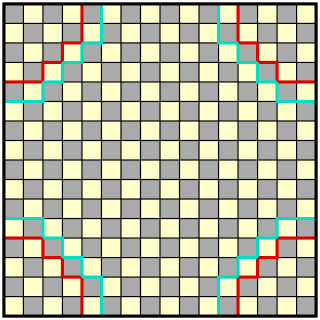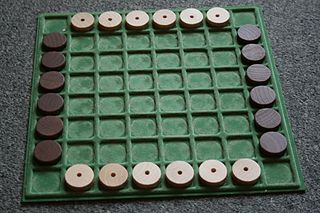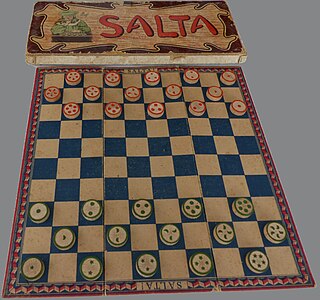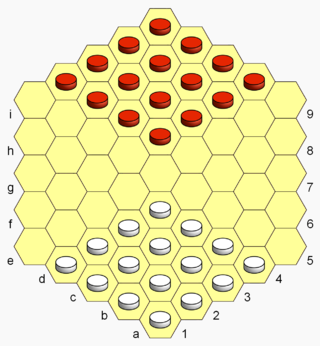
Sternhalma, commonly known as Chinese checkers or Chinese chequers, is a strategy board game of German origin that can be played by two, three, four, or six people, playing individually or with partners. The game is a modern and simplified variation of the game Halma.

Alquerque is a strategy board game that is thought to have originated in the Middle East. It is considered to be the parent of draughts and Fanorona.

Checkers, also known as draughts, is a group of strategy board games for two players which involve diagonal moves of uniform game pieces and mandatory captures by jumping over opponent pieces. Checkers is developed from alquerque. The term "checkers" derives from the checkered board which the game is played on, whereas "draughts" derives from the verb "to draw" or "to move".

Halma is a strategy board game invented in 1883 or 1884 by George Howard Monks, an American thoracic surgeon at Harvard Medical School. His inspiration was the English game Hoppity which was devised in 1854.
A Gamut of Games is an innovative book of games written by Sid Sackson and first published in 1969. It contains rules for a large number of paper and pencil, card, and board games. Many of the games in the book had never before been published. It is considered by many hobbyist gamers to be an essential text for anyone interested in abstract strategy games, and a number of the rules were later expanded into full-fledged published board games.
Three Musketeers is an abstract strategy board game by Haar Hoolim. It was published in Sid Sackson's A Gamut of Games. The game is notable in that, like the traditional fox and geese, it uses the principle of unequal forces; the two players neither use the same types of pieces nor the same rules, and their victory conditions are different.
Crossings is a two-player abstract strategy board game invented by Robert Abbott. The rules were published in Sid Sackson's A Gamut of Games. Crossings was the precursor to Epaminondas, which uses a larger board and expanded rules.

ZÈRTZ is the third game in the GIPF Project of seven abstract strategy games. The game features a shrinking board and an object that promotes sacrifice combinations. It is impartial: since neither player owns on-board pieces, maintaining the initiative is of fundamental importance.
Fox games are a category of asymmetric board games for two players, where one player is the fox and tries to eat the geese / sheep, and the opposing player directs the geese/sheep and attempts to trap the fox, or reach a destination on the board. In another variant, Fox and Hounds, the fox merely tries to evade the hounds. There are several versions known:

Fields of Action is an abstract strategy board game for two players.

Focus is an abstract strategy board game, designed by Sid Sackson and first published in 1964 by Kosmos. The game has been re-published many times since, sometimes under the titles Domination or Dominio. Focus won the 1981 Spiel des Jahres and Essen Feather awards. The game appears in Sackson's A Gamut of Games in the section New Battles on an Old Battlefield.

English draughts or checkers, also called straight checkers or simply draughts, is a form of the strategy board game checkers. It is played on an 8×8 checkerboard with 12 pieces per side. The pieces move and capture diagonally forward, until they reach the opposite end of the board, when they are crowned and can thereafter move and capture both backward and forward.

Kō shōgi is a large-board variant of shogi, or Japanese chess. The game dates back to the turn of the 18th century and is based on xiangqi and go as well as shogi. Credit for its invention has been given to Confucian scholar Ogyū Sorai (1666–1728), who also described the rule of the game in his book, Kōshōgifu (廣象棋譜).

Surakarta is a little-known Indonesian strategy board game for two players, named after the ancient city of Surakarta in central Java. The game features an unusual method of capture which is "possibly unique" and "not known to exist in any other recorded board game". Little is known about its history.
Cups was one of several games invented in 1965 by father and son Arthur Amberstone and Wald Amberstone who were both cofounders of the New York Gamers Association (N.Y.G.A.). They also invented Power, and High Deck, a card game based on medieval society. At the time both were working as basket makers as well as game designers in New York City. This game was first published in A Gamut of Games by Sid Sackson in 1969. Wald Amberstone co-founded the Tarot School in 1995 along with his wife Ruth Amberstone. The game Cups is a contemporary two-ranked single-lap member of the ancient game family of Mancala.

Conspirateurs is a two- or four-player strategy board game said to have been invented in 18th-century France. Robert Charles Bell believes the game to date from after 1789, following the French Revolutionary Wars, "a period of feverish political activity with factions conspiring against each other".
Dablo is a family of two-player strategy board games of the Sámi people. Different variants of the game have been played in different parts of Sápmi.

Lines of Action is an abstract strategy board game for two players invented by Claude Soucie. The objective is to connect all of one's pieces into a single group. The game was recommended by the Spiel des Jahres in 1988.

Salta is two-player abstract strategy board game invented by Konrad Heinrich Büttgenbach in 1899 in Germany. Büttgenbach (1870–1939) was born in Heerdt, near Düsseldorf, Germany. The game attained its highest popularity in the early 1900s before World War I especially in France and Germany. The World Trade Fair of 1900 in Paris exhibited a Salta board made of mahogany with golden counters adorned with more than 5,000 diamonds. Famous players were the US chess master Frank Marshall, the German World Chess Champion Emanuel Lasker, and the French actress Sarah Bernhardt.

Hexdame is a strategy board game for two players invented by Christian Freeling in 1979. The game is a literal adaptation of the game international draughts to a hexagonal gameboard.













